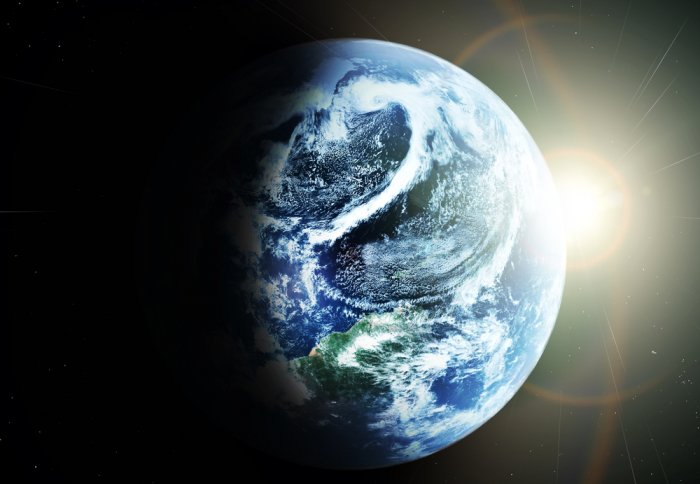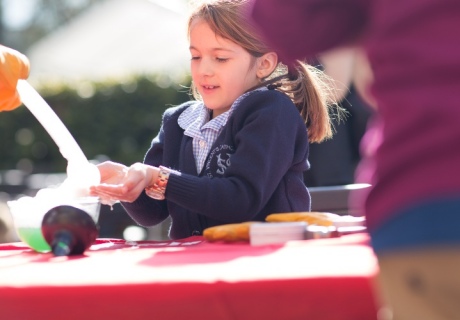Summer Science Exhibition: Extreme research on display at the Royal Society show
by Simon Levey

Explore the formation of the first stars and tinker with the evolution of tiny microbes this week at a free exhibition in central London.
At the annual Royal Society Summer Science Exhibition, Imperial College London researchers will be talking about the extremes of size, age and distance in science.
Interactive exhibits will include cosmic pictures of the first stars and galaxies, the epic hunt for the elusive Higgs boson, and a game that determines life or death for tiny, but deadly, microbes.
The exhibition opens to the public tomorrow (Tuesday 2 July 2013) giving visitors the chance to meet scientists, discover exciting new facts, ask questions about sensational scientific advances, and find out what it is like to work in research.
Imperial researchers are bringing other stimulating scientific topics to exhibition including: the water-filled moons and volcanic dwarf planets from the outermost reaches of our solar system; and the microscopic world of sugar molecules that allow cells to communicate with each other and could hold the key to developing food and medicine for the future.
Dr Daniel Mortlock is one of Imperial's astroscientists who will be at the exhibition, which runs until 7 July. When asked about his early memories of science, he said: "As a child I had a book about the planets of the solar system, which I thought was fantastic. I told a young friend about my favourite planet, Saturn, but he had only heard of Satan and that caused some kind of trouble."
The following exhibits will feature science and discovery from Imperial at the annual Royal Society Summer Science Exhibition in 2013. The event is free and open to the public at the Royal Society's headquarters at Carlton House Terrace, London SW1Y 5AG, on Twitter at @summerscience using the hashtag #SSE2013, and Facebook at facebook.com/summerscience.
Dawn of time
Visitors will be able to explore science from the Planck satellite, which launched in May 2009. Planck has surveyed the entire sky to search for the origin of the universe. It has captured the variations in the brightness of the cosmic microwave background, left over radiation from the Big Bang.
Dr Dave Clements, Professor Andrew Jaffe and Dr Daniel Mortlock (Department of Physics).
Clever microbes
This exhibit will explore the science of bacteria's sensory systems. All living organisms need their senses to find food and respond to dangers in their environment. Bacteria are single-celled organisms: they don’t have brains, but still need to make decisions based on information about their surroundings. Scientists need to understand these processes in order to help devise new methods of fighting bacterial infections and antibiotic resistant bacteria.
Dr John Pinney, Dr Sarah Fillipi, Adam MacLean, and Siobhan Mc Mahon (Department of Life Sciences).
Higgs boson
At the smallest distances, physicists describe the world in terms of elementary particles. The behaviour of these particles is described by a set of theories referred to as the Standard Model of Particle Physics. Visitors to this exhibit can find out about the hunt for the Higgs boson, which was announced to much fanfare in July 2012, by scientists at the ATLAS and CMS experiments of the epic sized particle accelerator at CERN. Scientists are excited that these results will provide new insight into how the Universe is made.
Professor Paul Dauncey (Department of Physics)
Ice worlds
Visitors to this exhibit will find out about the moons of the outer planets in our solar system, many of which have atmospheres, volcanoes that erupt water, and underground oceans. Astronomers, physicists and chemists use their expertise to understand the gravity, orbits, compositions and atmospheres of these icy worlds, and how their surfaces are altered by being exposed to radiation. Future space missions will determine whether it's possible for humans to inhabit some mysterious space objects further away than Pluto.
Dr Marina Galand and Dr Ingo Mueller-Wodarg (Department of Physics).
Sweet complexity
Sugars such as sucrose, starch and cellulose provide energy for living cells and are important molecules in food and medicines. This exhibit will explore how cells of the body communicate via a sugary coating called the glycocalyx, which is involved in fertilisation and the body's response to infection and cancer. In future scientists say this research can help improve human fertility treatments, developing anti-flu medicines and create new personalised anti-cancer treatments.
Professor Anne Dell and Dr Stuart Haslam (Department of Life Sciences).
Street science
In addition to the exhibits during the week, this weekend sees Dr Simon Foster and his buskers showcasing some street science outside the famous building. Visitors will get a chance to make waves, see objects disappear in front of their very eyes and ‘juggle clouds’ among a host of other interactive demonstrations.

A cloud in the hand is worth two in the sky!
Dr Simon Foster (Outreach Lab)
Article supporters
Article text (excluding photos or graphics) © Imperial College London.
Photos and graphics subject to third party copyright used with permission or © Imperial College London.
Reporter
Simon Levey
Communications Division